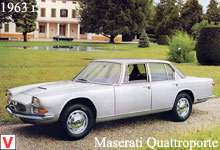Double open car Maserati Spyder began to produce at the plant in the Italian Modena in 2001. The presentation of the model took place in the autumn of the same year at the Frankfurt Motor Show. A remarkable fact, the development of this project began immediately after the company Maserati came under the control of Ferrari.
The car was created on the basis of the 3200 GT coupe, but was technically significantly upgraded. The completely new Spyder body, developed by ItalDesign-Giugiaro ateliers, received a wheelbase shortened to 2440 mm and an automatic electro-hydraulic folding mechanism for a soft awning that swallowed a seat behind the front seats, resulting in a two-seater roadster. That Spyder was the first model of the brand Maserati, presented in the US market after an 11-year hiatus. The basis of the appearance of the Spyder - conciseness, elegance, recognition. Designers abandoned bright, conspicuous details, for example, the “gills” on the hood disappeared.
Trim is made in the corporate style of the company Maserati: at least pretentiousness, everything is discreet, but very functional. The dashboard looks very technical. The speedometer has two classic mechanical odometer mileage. The tachometer has a large, clear digitization.
In the corners of the panel are placed secondary devices, among which are not only the engine temperature or fuel level indicator in the tank, but, for example, the voltage indicator in the vehicle’s electrical system. Design solutions, tangible quality finishes and generous equipment are merged here. For the first time in many years, Maserati engineers returned to normal aspirated engines. Under the hood, the Spyder is an aspirated 4-volume V8 engine. 2 liters capacity of 390 hp at 7000 rpm., the moment of 451 Nm (4500 rpm.). The engine received variable valve timing, a dry sump lubrication system, etc. The Maserati Spyder can accelerate to a hundred in 5 seconds.
Gearbox - manual or robotic, both six-speed. In order to distribute curb weight in the ratio of 53: 47% (front and rear wheels), the gearbox was moved to the rear wheels and interlocked with the main gear case (Transaxle scheme). For the Spyder model, a new mechanical, automated 6-speed Cambiocorsa transmission was specially developed. Cambiocorsa is a proprietary electro-hydraulic clutch control system. In other words, the six-speed manual transmission of the car can work both in manual and in fully automatic modes. Switching the box by using the two steering column levers.
There are 4 control algorithms for such a box: Normal, Sport, Low Grip (for slippery surfaces) and Auto. The first three are manual. Normal mode is focused on ensuring maximum stability of the car, taking into account road conditions, while sport mode - on ensuring the highest acceleration intensity; in this case the torque continues to be transmitted to the driving wheels even at the beginning of their slipping. The Normal or Sport modes correspond to the individual algorithms of the ASR traction control system.
By the way, there are two anti-skid systems: ASR prevents the wheels from slipping during acceleration, and MSR when braking the engine. The list of options was a Skyhook adaptive suspension with adjustable shock absorber stiffness, which was developed in collaboration with the German engineers Mannesmann-Sachs. This system allows the car to instantly adapt to the state of the road surface. The on-board computer monitors the amount of wheel travel, body position, lateral accelerations and speed and continuously adjusts the damping stiffness. For effective braking, ventilated and perforated brake discs with a diameter of 330 mm (front) and 310 mm (rear) are provided.
The GranSport Spyder version, which debuted in 2005, had a slightly more powerful engine (401 hp), a robotic gearbox and an adaptive suspension. Externally, it is distinguished only by a new front spoiler and an impressive 19-inch wheels. The model was produced before 2007. This system allows the car to instantly adapt to the state of the road surface.
The on-board computer monitors the amount of wheel travel, body position, lateral accelerations and speed and continuously adjusts the damping stiffness. For effective braking, ventilated and perforated brake discs with a diameter of 330 mm (front) and 310 mm (rear) are provided. The GranSport Spyder version, which debuted in 2005, had a slightly more powerful engine (401 hp), a robotic gearbox and an adaptive suspension. Externally, it is distinguished only by a new front spoiler and an impressive 19-inch wheels. The model was produced before 2007. This system allows the car to instantly adapt to the state of the road surface.
The on-board computer monitors the amount of wheel travel, body position, lateral accelerations and speed and continuously adjusts the damping stiffness. For effective braking, ventilated and perforated brake discs with a diameter of 330 mm (front) and 310 mm (rear) are provided. The GranSport Spyder version, which debuted in 2005, had a slightly more powerful engine (401 hp), a robotic gearbox and an adaptive suspension. Externally, it is distinguished only by a new front spoiler and an impressive 19-inch wheels. The model was produced before 2007.
For effective braking, ventilated and perforated brake discs with a diameter of 330 mm (front) and 310 mm (rear) are provided. The GranSport Spyder version, which debuted in 2005, had a slightly more powerful engine (401 hp), a robotic gearbox and an adaptive suspension. Externally, it is distinguished only by a new front spoiler and an impressive 19-inch wheels. The model was produced before 2007. For effective braking, ventilated and perforated brake discs with a diameter of 330 mm (front) and 310 mm (rear) are provided. The GranSport Spyder version, which debuted in 2005, had a slightly more powerful engine (401 hp), a robotic gearbox and an adaptive suspension.
Externally, it is distinguished only by a new front spoiler and an impressive 19-inch wheels.






